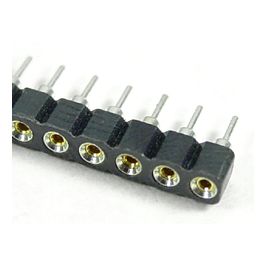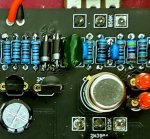You are using an out of date browser. It may not display this or other websites correctly.
You should upgrade or use an alternative browser.
You should upgrade or use an alternative browser.
What Kind of Socket for a Diode?
- Thread starter farwest1
- Start date
You can cut up a regular 8pin IC socket, or use a row socket like this.

 www.taydaelectronics.com
www.taydaelectronics.com
In either case trim the pin(s) in the middle that would interfere with the board.

40 Pin 2.54mm DIP SIP IC Sockets Adaptor Solder Type
Lead Free - Get It Fast - Same Day Shipping
In either case trim the pin(s) in the middle that would interfere with the board.
Nostradoomus
Well-known member
I usually clip off single SIP sockets and solder them in there with the help of some blue tack.
Barry
Well-known member
I'm usually doing a bank of diodes 2 or more, since they all line up and are spaced equally I just snap off however many SIP and put one on each side, I rarely socket diodes anymore thoughI usually clip off single SIP sockets and solder them in there with the help of some blue tack.
It's tight because diode pins are sometimes considerably larger than what will fit in a machined pin SIP. Especially zeners and 400x series. Typical socketed stuff is usually smaller pins such as 914/4148, and even some of the 1N34's. Zeners and power diodes don't get socketed as much.
Chuck D. Bones
Circuit Wizard
There is another option instead of using sockets. It's ugly, but will work fine for testing on the bench or in the studio. Solder in short stubs of wire where the diodes would go, then use clip leads to temporarily connect the diodes you wish to audition. Once you find the diodes you want, install them permanently. I have used this method to select the tone capacitor in a guitar.
Still another way to do it is to breadboard the pedal circuit and try different diodes (or anything else) on the breadboard. It's pretty involved and requires patience, but the end result is you'll know exactly which parts you want on the PCB before you start building.
Still another way to do it is to breadboard the pedal circuit and try different diodes (or anything else) on the breadboard. It's pretty involved and requires patience, but the end result is you'll know exactly which parts you want on the PCB before you start building.
There is another option instead of using sockets. It's ugly, but will work fine for testing on the bench or in the studio. Solder in short stubs of wire where the diodes would go, then use clip leads to temporarily connect the diodes you wish to audition. Once you find the diodes you want, install them permanently. I have used this method to select the tone capacitor in a guitar.
Still another way to do it is to breadboard the pedal circuit and try different diodes (or anything else) on the breadboard. It's pretty involved and requires patience, but the end result is you'll know exactly which parts you want on the PCB before you start building.
That's a really clever idea I'm definitely going to use!! Thanks!!
Ratimus
Active member
If you play your cards right, Chuck's method allows you to bend and trim the leads of your diodes and solder them in from the component side of the board once you're ready to permanently install them. You can even leave the board installed in the enclosure when you do it (assuming you have sufficient clearance to avoid melting any neighboring components).
Chuck D. Bones
Circuit Wizard
Requires a very light touch to do that, because as you're soldering to the stub lead on one side of the board, the solder on the other side is likely to melt. Ratimus, you must have some mad soldering skills!
Ratimus
Active member
*Desolder and remove the stub leads first*Requires a very light touch to do that, because as you're soldering to the stub lead on one side of the board, the solder on the other side is likely to melt. Ratimus, you must have some mad soldering skills!
Chuck D. Bones
Circuit Wizard
And you can do that without removing the board?
Ratimus
Active member
Yes? As long as it's not too densely populated. Plated through holes make it easier, but aren't strictly necessary. I'm not sure I'm describing it accurately though? It shouldn't be hard. See pics: The 1N4148s are before, the 1N5817s are after (pardon the flux).And you can do that without removing the board?
Attachments
farwest1
Member
If I do this method, can I solder the stub lead to the diode lead once I find the one I like?There is another option instead of using sockets. It's ugly, but will work fine for testing on the bench or in the studio. Solder in short stubs of wire where the diodes would go, then use clip leads to temporarily connect the diodes you wish to audition. Once you find the diodes you want, install them permanently. I have used this method to select the tone capacitor in a guitar.
Still another way to do it is to breadboard the pedal circuit and try different diodes (or anything else) on the breadboard. It's pretty involved and requires patience, but the end result is you'll know exactly which parts you want on the PCB before you start building.
I guess my noob question is: can a lead wire be soldered to another lead wire without loss of signal? Maybe this is an obvious yes.
Similar threads
- Replies
- 0
- Views
- 124



